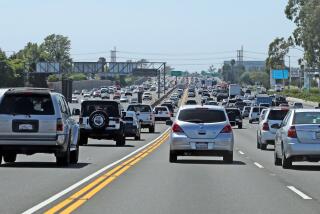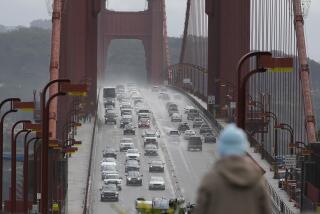Cars Can Speed Up; People Can’t
- Share via
Back in the ‘60s, we thought cars would someday zoom along American highways at 120 m.p.h., the result of ever improving horsepower under the hood and the insatiable desire of motorists for ever more speed.
After all, speed and productivity created the demand for cars in the first place. Computers operate faster every year, so doesn’t it follow that transportation would gradually improve its efficiency as well?
“We are still driving cars slower than we were in 1972, nearly 20 years ago, and yet the technology has improved to make it much safer,” says Dru Whitledge, author of a new book on speed limits. “Speed limits are too slow.”
Whitledge’s book, entitled “The Safe Motorist’s Guide to Speedtraps,” is written for that vast segment of our society that owes no allegiance to speed limits. It is a state-by-state listing of speed traps and police radio frequencies for those who want to avoid the police.
Since the 1960s, cars have become equipped with steel-belted radial tires, air bags, energy-absorbing crash systems and anti-lock brakes--a formidable assortment of high-technology safety gear, Whitledge argues.
It would seem that speed limits should be inching ever higher because cars have become safer. And drivers have become more aware of the hazards of alcohol abuse, if for no other reason than that state governments have lowered the legal definition of drunkenness.
Nonetheless, it is unlikely that cars will ever legally exceed the existing 55-m.p.h. limits on most urban highways and 65 m.p.h. on rural interstates.
What happened? The 1970s energy crisis made fuel conservation a top priority. Cutting air pollution meant cutting engine power. And the 50,000 motorists left dead every year on our highways during the 1960s was too much carnage. The annual death toll now amounts to about 45,000, even though motorists drive more than in the past.
Despite the improvements in safety equipment and alcohol awareness, higher speed does relate to greater death.
On the rural interstate freeways where the speed limits have increased to 65 m.p.h., fatalities are up by 25%, according to Alan Williams, vice president for research at the Insurance Institute for Highway Safety.
“What we are gaining is a few minutes per trip for most motorists, and on that basis it doesn’t seem reasonable,” Williams said.
As soon as speed limits are lifted, motorists who normally drive faster increase their speeds above the new top.
The insurance institute found in a survey in several states that from 8% to 14% of passenger cars go faster than 70 m.p.h.
Across the nation, 400 to 500 people will die each year on the freeway segments that have had just a 10-m.p.h. increase in the speed limit, according to the institute.
Many people still hope that technology will ultimately solve the problems of pollution, safety and fuel conservation so that we can have cars move more quickly. If cars could move faster, it would help clear congestion by cutting the number of cars on the road at any given moment, the so-called occupancy factor.
But don’t count on it any time soon, according to Clarence Ditlow, director of the Center for Auto Safety, a Washington-based consumer group.
“People talk about intelligent highway systems, but I don’t see it within our ability to afford it,” Ditlow said. “We are having trouble keeping roads and bridges in good condition.”
More to Read
Sign up for Essential California
The most important California stories and recommendations in your inbox every morning.
You may occasionally receive promotional content from the Los Angeles Times.











